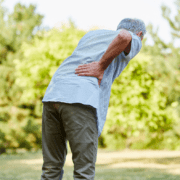5 Expert Tips to Treat Back Pain Naturally and on your Own
Back pain impacts approximately 31 Million Americans at any given time, and our health care system spends $50 Billion per year on low back pain treatment.
It’s the single leading cause of disability keeping people out of work, and it’s the second most common reason for doctor’s visits. Back pain is a big problem in this country. But the even bigger problem, in my opinion, is how the traditional medical system treats and manages those suffering from back pain.
Despite what you may have been told, getting rid of back pain on your own is entirely possible and preventing it can be even easier.
But it starts with understanding what the true cause of back pain is for most people. Eighty percent of back pain is “mechanical” in origin, which means it’s not due to any serious pathology like cancer, infection, or fracture. Mechanical back pain is the result of abnormal or unusual forces occurring in the structures of your spine – like your ligaments, muscles, discs, and vertebrae. These abnormal forces can accumulate slowly over your lifetime or happen quickly in a single event – such as picking something up the wrong way. The good news is that if abnormal forces can cause your back pain, then reversing those forces can get rid of your back pain. Surgery and other medical procedures won’t do that. They only impact the structure or irritant that is aggravated, like when you remove a piece of your bulging disc. The goal for true back pain recovery is to eliminate what is causing those structures to be aggravated in the first place – and the best way to do that is with healthy movement you can do on your own!
Here are 5 tips to help you minimize abnormal forces on your spine so you can avoid procedures and surgery!
1. Stop sitting so much
Compressive forces on your spine increase by 40% when you sit – and it goes up even more if you’re slouched! Over time, these compressive forces will start to aggravate the ligaments and discs in your spine. Because it happens slowly, you may not notice right away, so one of the best things you can do is interrupt your sitting at least every 30 min. This minimizes the accumulation of abnormal forces on your spine throughout the day.
2. Walk more
Our spines were designed to be upright and moving. Walking is one of the best and easiest ways to promote this. When you walk regularly, it helps to promote good mobility and blood flow, which can act like lubricant for the structures in your spine. Walking also helps to keep your hips from getting tight. Tight hips can cause abnormal forces to occur at your pelvis, which in turn, will create abnormal forces on your spine.
3. Vary your posture
You might be wondering why I didn’t say “maintain good posture”. To be honest, perfect posture all the time is kind of a myth when it comes to back pain. The truth is your spine is quite resilient and should be able to tolerate lots of different postures – even bad posture for a short period of time – without pain. The problem is when we assume the same posture all the time. Imagine if you never straightened your knee, eventually it would get stiff and be difficult to move in that direction. The same thing happens in our spines. One of the best things you can do is choose activities (like Yoga or Pilates) that work your spine through lots of different postures and range of motion. This helps keep your spine happy and healthy and it minimizes abnormal forces from the same repeated postures or activities day after day.
4. Strengthen your core
The stronger you are, the more resilient your body is going to be – period. When it comes to back health, having a good strong core is going to minimize stress on ligaments and even discs. When the muscles around your spine are strong, it’s going to be easier for you to lift and carry things, which is one of the most common ways people injure their backs. If your abdominals, glutes, and hips aren’t doing their job, your spine ends up taking more of the stress – and this can lead to both pain and injury. Pilates is my favorite way to strengthen your core because the exercises are designed to target your abdominals.
5. Educate yourself
There is a lot of misinformation out there when it comes to both diagnosing and treating back pain. You should never let an MRI or X-ray alone dictate what your treatment should be. Remember, the structures in your back don’t get spontaneously irritated. Irritation typically occurs due to abnormal forces on your spine. If you only address the irritated structure – like with an injection, procedure, or surgery – you’re not actually fixing the problem. The best way to address abnormal forces in your spine is with movement – movement that is designed to even out the forces in your spine and relieve pressure from those structures that have become aggravated.
If you’re currently suffering from back pain and want to avoid having to resort to medication, procedures or surgery – then give these tips a try. But if you’ve tried these tips and you continue to struggle – then consider consulting with a mechanical back pain expert who can help you get rid of back pain naturally – and with corrective movement and lifestyle strategies.
Dr. Carrie Jose, Physical Therapist and Pilates expert, owns CJ Physical Therapy & Pilates in Portsmouth and writes for Seacoast Media Group. To request a free copy of her guide to back pain CLICK HERE or to get in touch, email her at [email protected].



